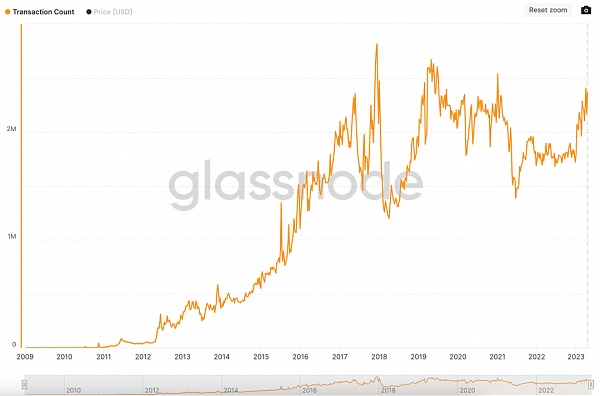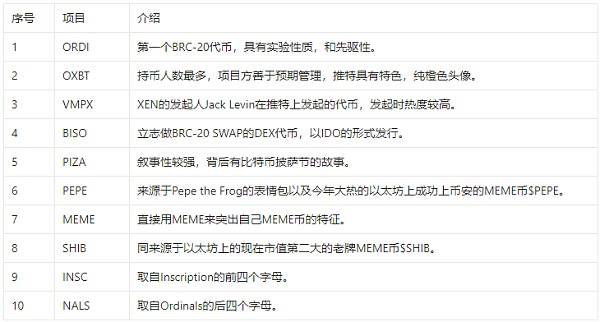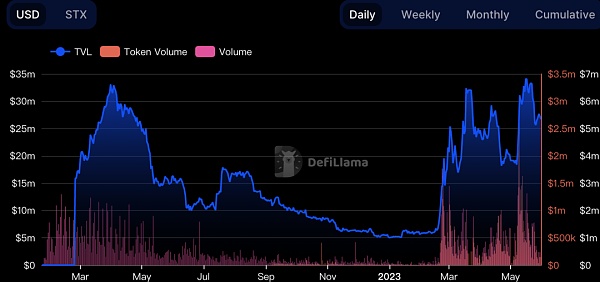Overview of Key Projects in the BTC Ecosystem
Author: Lucky, Biteye Core Contributor
Editor: Crush, Biteye Core Contributor
The BTC ecosystem has been thriving for two months, but with the pullback of ORDI, many people are starting to worry that this wave of BTC ecosystem enthusiasm has come to an end. So, let's first look at the data to see if this ecosystem is still worth following.
At the same time, this article brings you a detailed review of key projects in this ecosystem.
Current Status of the BTC Ecosystem
From the daily active address count of BTC, we can see from the Glassnode data in the chart below that the number of on-chain active addresses for BTC has shown an upward trend from the beginning of the year to now. Additionally, the trading volume has also significantly increased. From the current level of activity in the BTC ecosystem, it has not weakened due to the price drop of ORDI, indicating that this ecosystem is still very vibrant.

Figure: Weekly Active Address Trend, Source

Figure: Weekly Trading Volume Trend, Source
So, with the BTC ecosystem still thriving, what projects are worth our attention? Below, we will highlight some key projects in the BTC ecosystem.
Categories are as follows: (You can jump to the category of interest)
Ordinals NFT Projects
BRC-20 Projects and Other Standards
L2 and Sidechain Projects
DeFi Projects
Ordinals NFT Projects
The Ordinals protocol is a system for numbering satoshis (sats). By assigning a serial number to each sat, Ordinals tracks them in transactions, while users can attach additional data (images, videos, text, etc.) to the Bitcoin blockchain, making each sat unique and giving it NFT-like properties.

Figure: Top Five NFT Series by All-Time Trading Volume
From the total trading volume of Ordinals NFTs shown in the above chart, the top five are Bitcoin Punks, Bitcoin Frog, Pixel Pepes, Bitcoin Apes, and DeGods. In the past 30 days, DogePunks and Naked Bitcoin Frogs Misprints have also made it into the top five. Let's introduce these projects one by one:

Figure: Top Five NFT Series by 30-Day Trading Volume, Source
Bitcoin Punks is the first project to use the Ordinals protocol, inspired by CryptoPunks on Ethereum, successfully bringing the CryptoPunk concept to the Bitcoin NFT space. The current floor price is 0.0068 BTC.
Bitcoin Frogs consists of 10,000 generated frogs, free to mint, with no roadmap or airdrop. The founder is anonymous, and it is known for its meme narrative, achieving widespread dissemination. The current floor price is 0.092 BTC.
Pixel Pepes is a project airdropped by Ordinals Wallet on February 28, with a total of 1,563 pieces. The airdrop condition was to have traded at least once with the wallet before block 777888. The airdrop has now ended, and the current floor price is 0.164 BTC.
DeGods is an NFT project from Solana that was issued on the Bitcoin network in March. This NFT series has a total of 534 pieces (as 534 pieces were previously destroyed on Solana, they plan to reissue them on the Bitcoin network), of which 500 pieces will be minted on Bitcoin at a price of 0.444 BTC. The remaining 34 DeGods will be auctioned/raffled off in the form of DUST tokens, with a current floor price of 1.07 BTC.
DogePunks is a Bitcoin Ordinals project that combines the concepts of Dogecoin and CryptoPunks, with a total of 10,000 pieces. The current floor price is 0.0166 BTC.
Naked Bitcoin Frogs Misprints is a project derived from the Bitcoin Frogs release, where a clothing layer error resulted in some frogs appearing without clothing, creating images of naked frogs. This project has meme attributes and discussion value, leading to its high popularity. The current floor price is 0.0203 BTC.
Other noteworthy projects include: Sub 10K, as each Bitcoin NFT has an inscription serial number, Sub 10K refers to the earliest 10,000 Bitcoin NFTs, which have early value. Ordinals Punks is one of the series within Sub 10K.
BRC-20 Projects and Other Standards
The BRC-20 standard is based on the Ordinals protocol, allowing for the deployment, minting, and transfer of tokens by writing information such as token name and total supply in a standardized JSON format into sats.
From the trading volume trend of BRC-20 shown in the chart below, it can be seen that the popularity of BRC-20 has been continuously rising. Even though the leading $ORDI has seen a drop of over half, its trading volume has not been significantly affected, indicating that people's attention and funds have not withdrawn too much from the BRC-20 ecosystem.

From the Chaineye tool website, the current top five BRC-20 tokens by market cap are ORDI, OXBT, OG, VMPX, and BISO. Below, I have listed these tokens along with some other noteworthy tokens:


ORC-20: Due to three major issues with the BRC-20 standard:
1) The token supply and maximum minting amount cannot be changed, limiting the development of the token;
2) Token naming is limited to 4 digits;
3) BRC20's "Inscribe Transfer" and "bookkeeping" heavily rely on external centralized indexing services;
To address these issues, the ORC-20 standard was born. ORC-20 removes the token naming restrictions and adds upgradeable features, allowing project teams to empower their tokens further. It also introduces advanced features such as setting royalties and whitelists.
Currently, the mainstream ORC-20 token situation is as follows:

However, due to the underdeveloped infrastructure of ORC-20 and the wealth effect still concentrating on BRC-20, ORC-20 is currently receiving limited attention.
SRC-20: In addition to BRC-20 and ORC-20, SRC-20/21 has also attracted some attention. SRC-20/21 is a token standard developed based on the Stamps protocol. BTC Stamps was invented by @mikeinspace, and its main difference from Ordinals is that Ordinals' image/text information is stored in witness data, while Stamps data is stored in transaction outputs. This difference creates an important feature of Stamps: it can always exist on the BTC chain, and all nodes must synchronize this data.

Compared to ORC-20, the infrastructure development of SRC-20 is somewhat more complete. However, there is currently no large consensus trading market, and the number of users is relatively small.
While Stamps does have a trading market, the process experience is not as smooth as that of the BRC-20 trading market. According to a recent announcement from Hiro Wallet, it will integrate SRC-20 tokens, making it easier for users to view their assets. As the infrastructure for this standard improves, it may deserve more attention.

BRC-721: BRC-721 is a standard similar to the Ordinals protocol. However, the current Ordinals protocol lacks a way to categorize NFT projects into a specific collection, making it heavily reliant on centralized service providers for accounting and retrieval.
The emergence of BRC-721 aims to solve the creation and verification of decentralized NFT collections. The BRC-721 protocol is based on three types of manifests:
1) CollectionManifest (Collection Manifest)
2) InscriptionManifest (Inscription Manifest)
3) RevealManifest (Reveal Manifest)
Each manifest has protocol and version fields, allowing third-party services to understand the specifications for API integration and queries, thereby building corresponding applications.
Currently, the development of this standard is in a relatively early stage and is worth tracking and monitoring. A well-known project is Ordibots, issued by @0xJerry543, with a total of 1,000 pieces and a floor price of 0.077 BTC.

L2 and Sidechain Projects
As the number of transactions on BTC increases, how to leverage the underlying security of BTC while allowing it to handle more transactions has become one of the current development directions. At the same time, with the halving approaching, the issue of miner profitability is gradually surfacing.
Due to the limitations of BTC block generation, the attractiveness of a single block reward for miners' future earnings may be limited. To ensure the long-term development of BTC, two types of solutions have emerged: BTC L2 and sidechain solutions.
Next, we will introduce some key projects:
L2
Lightning Network
The Lightning Network was proposed by Joseph Poon and Tadge Dryja in 2016 and is one of the Bitcoin Layer 2 solutions. The Lightning Network consists of payment channels designed to enable fast and low-fee transactions, allowing users to make off-chain payments without confirmation, with final settlement occurring on the main chain. Theoretically, the Lightning Network can achieve a processing speed of millions of transactions per second.
The development of payment channels in the Lightning Network shows that the capacity has maintained a high growth trend since 2022. However, the number of channels saw significant growth from 2021 to 2022, while there was not much growth from 2022 to 2023.

Stacks
The technical architecture of Stacks includes a core layer and a mainnet, allowing developers to choose either for development. The Stacks verification mechanism uses a consensus algorithm called POX (Proof of Transfer), employing an anchored transaction method to ensure the security of transactions by broadcasting the block information of transactions on the Stacks chain to the Bitcoin network.
Stacks has a complete execution environment (i.e., any application that can be built on chains like Ethereum can also be built on the Stacks layer).
In Stacks, transaction validators and miners can stake $STX and $BTC respectively to mine $BTC and $STX tokens to maintain network security.

From the Stacks roadmap, the launch of the Nakamoto network and SBTC in Q4 of this year will be significant milestones in the development of Stacks, worthy of close attention.
The potential impacts of these two major updates are as follows:
1) Stacks transactions can obtain final confirmation from Bitcoin, increasing security on Stacks;
2) Increased block generation speed, allowing for quick transaction confirmations, potentially achieving a block generation speed of 4-5 seconds as described in its white paper;
3) Support for subnet custom development languages, meaning subnets can support other programming languages and execution environments (e.g., Ethereum's Solidity);
4) Introduction of the on-chain native asset SBTC, greatly increasing the possibility of establishing a financial ecosystem on BTC L2.
From the development situation of Stacks shown in the chart below, its daily active address count is currently less than 4,000. There was a significant increase at the beginning of this year (due to price increases and BTC Ordinal narratives), followed by a sharp decline. Compared to 2022, there has only been slight growth.
In contrast to the 200,000 daily active addresses of the popular ETH L2 Arbitrum, the gap remains significant. Although its TVL growth has been good, the total TVL amount is still relatively low, indicating that this ecosystem is currently in a niche stage in terms of both users and funds.

Figure: Daily Active Address Count, Source

Figure: Stacks TVL Changes
Sidechains
Rootstock
RSK is a Bitcoin sidechain project developed by IOV Labs. It uses Bitcoin's mining algorithm, allowing Bitcoin miners to engage in "merged mining" while also earning transaction fee income from Rootstock.
The native token of Rootstock is a Bitcoin-pegged token called rBTC. The company has also developed RIF (Rootstock Infrastructure, token $RIF), a platform built on Rootstock designed to provide blockchain infrastructure and services for developers, including domain names, storage, authentication, etc., to support dApp development and deployment.
Liquid Network
The Liquid Network is a Bitcoin sidechain developed by Blockstream, aimed at providing faster, cheaper, and more secure transaction services. It supports the trading of cryptocurrencies and assets and offers features such as confidential transactions and batch transactions.
DeFi Projects
ALex
Alex is currently one of the most important protocols on Stacks. As of May 29, the TVL on Stacks was 28.31M, while ALEX's TVL was 26.7M, accounting for a large portion of the TVL on this chain.
Currently, Alex has mainstream DEX functionalities, including Swap, Add Liquidity, and Stake. However, due to the popularity of BRC-20, Alex has also developed a Beta version for BRC-20 trading.
The Beta version uses an order book model, and users can already experience it (with relatively low liquidity). In addition to trading, Alex also supports a Launchpad to help other projects with initial token issuance. However, due to the current lack of richness in the Stacks ecosystem, both trading volume and Launchpad performance are average.
As the Stacks ecosystem gradually develops, Alex, as the leading DEX in this ecosystem, will also benefit from simultaneous growth.
From the trading volume and TVL of Alex shown in the chart below, it can be seen that since March, the project has gradually gained attention, with significant growth in both trading volume and TVL.

Arkadiko
Arkadiko is the second-largest protocol by TVL in the Stacks ecosystem, with a TVL of 6.9M (Data Source: https://info.arkadiko.finance/). Arkadiko is a protocol similar to Maker DAO.
It allows users to mint stablecoins (USDA) by over-collateralizing STX. The project also supports SWAP and Lending, but currently, there are only seven trading pairs available for SWAP, and three assets available for lending: STX, xBTC, and ALEX.
As one of the early projects on Stacks and the largest lending project, if such projects can keep up with the development of the ecosystem, they have the opportunity to occupy a leading position and share in the ecosystem's growth.
MoneyOnchain
MoneyOnChain is a decentralized, Bitcoin-backed stablecoin protocol built on RSK. Its transactions require RBTC as a fee, and users can mint stablecoins (DOC) by collateralizing rBTC. It has also issued $BPro, a leveraged product based on BTC.
Conclusion
This article introduces some standards and projects within the BTC ecosystem. For the BTC ecosystem, BRC-20, SRC-20, and BRC-721 are standards worth paying attention to. In terms of L2 and sidechain projects, Lightning Network, Stacks, and Rootstock are important projects. In the DeFi space, Alex, Arkadiko, and MoneyOnChain are protocols worth following.









